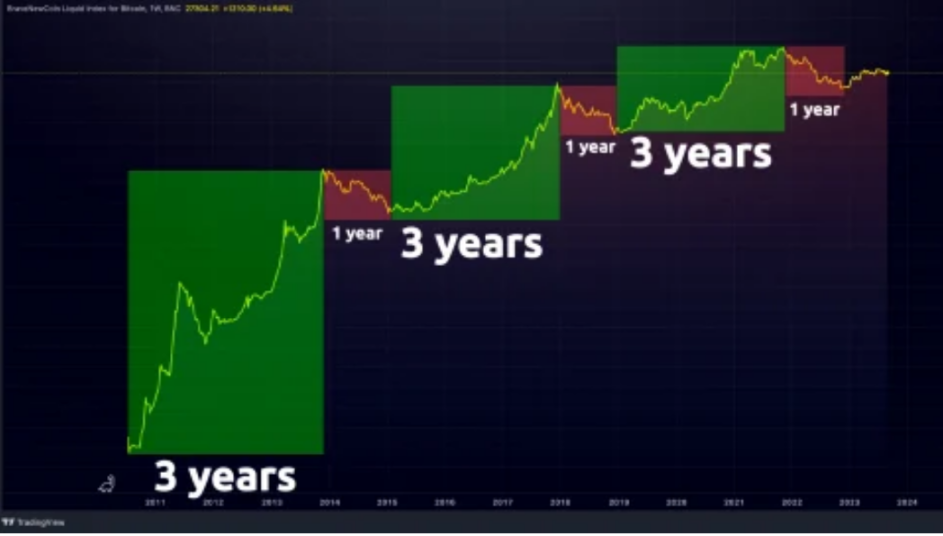Is Bitcoin going through a “16-year historical cycle”? How to find cycle tops?
Original author: Jeroen van Lang
Original compilation: Frank, Foresight News
Everyone has heard about the 4-year bull-bear cycle that Bitcoin is going through, but have you ever thought that Bitcoin might be going through an even bigger cycle? Could this larger cycle reflect the way humans adopt new technologies? Is it possible that weve seen something similar before, like the internet?
In this article, we’ll dive into a new theory that suggests Bitcoin is going through a larger 16-year cycle, which could help us predict the direction of Bitcoin’s price in the coming years.
Bitcoin’s regular “4-year cycle”
Bitcoin tends to go through a 4-year cycle, which is divided into two parts: an upward trend and a downward trend.
A regular 4-year cycle basically consists of a 3-year uptrend followed by a 1-year downtrend (also called a bear market). Bitcoin has completed 4 such cycles so far and has shown incredible accuracy, catching the attention of market participants.

internet cycle
One cannot ignore the similarities between the market structure of the SP 500 during the dot-com cycle and the Bitcoin cycle. Conventional financial markets also go through clear 4-year cycles, most of which are in uptrends, while downtrends (also called bear markets) are short-lived.
From my perspective, the dot-com cycle started around 1986 because thats when Microsoft went public and was one of the biggest companies in the dot-com cycle.
Bitcoins first 3 4-year cycles look very similar to the SP 500s first 3 4-year cycles starting in 1986.

This really piqued my interest because both periods were based on the adoption of a completely new technology that changed the way our society perceives and uses information.
For example, personal computers and the Internet have revolutionized our lives to the point where it is almost unimaginable not to be connected to the Internet for more than 24 hours. In the future, it is also unimaginable not to own and use any Bitcoin, so we are still in the early stages of adoption. .
So, can the development structure of the Internet cycle help us determine Bitcoin’s potential cycle path? First, I want to emphasize the fact that market cycles are, in my opinion, one of the best ways to use rough price predictions and determine when to enter and when to exit a specific market, but I really want to emphasize the word rough .
Because there is a saying: History does not simply repeat, but it always has the same rhyme. I think this also applies to cycles. Nothing can 100% replicate anything that has happened before, but it can give us a rough estimate of what might have happened.
As you can see in the structure of how Internet cycles develop, the first 3 4-year cycles are very similar, a long-term bull market followed by a brief but sometimes mild bear market or correction.
Only the last 4-year cycle is different, where the situation is completely reversed. It began with an acceleration in prices that was short-lived and followed by a multi-year bear market.
Will Bitcoin make a similar move? Disappoint those expecting a regular 4-year cycle and surprise most people, ending up in a multi-year bear market?
Microsoft is replicating a similar path - it started with 3 normal 4-year cycles, followed by an inverted 4-year cycle, which resulted in a secular bear market for an asset that had been in a strong bull market for many years.

Microsoft reached its bull market peak in 2000, marking a long-term price high of around $60. It was not until 2015 that this price record was broken again.
That means it took 15 years from that high to fully recover and surpass that level again. If we consider the money supply, Microsoft actually took longer to recover and break out of the prior high 21 years later in May 2021.

Both charts, Microsoft and the SP 500, are a true testament to the magnitude of the correction after a long-term bull market.
From a human perspective, it is difficult to imagine a long-term bear market in an asset that has been rising most of the time. So, is a similar situation possible for Bitcoin?
intersection between cycles
So, let’s take a look at what these cycles predict for Bitcoin and how we can prepare for these outcomes. First, its interesting to note that there is one date that predicts the same outcome in both the regular 4-year cycle and the 16-year cycle:
The regular 4-year cycle suggests that we will remain in an uptrend until 2025, followed by a year of decline. This is a typical 4-year cycle that we have seen 3 times in Bitcoin history.
And based on the 16-year cycle, we may be following a similar path to the dot-com bubble mentioned above - Bitcoin will peak in the first half of the cycle, so late 2024 at the latest, followed by a multi-year decline into 2026, forming New lows.
How to find cycle tops
One of the best indicators that Bitcoin traders can use is the Bitcoin funding rate, which basically shows whether the majority of market participants in the derivatives market are short or short Bitcoin.
I find this indicator very useful for spotting Bitcoin price tops because in a healthy bull market, when funding rates are negative, prices tend to rise. In a bear market, when funding rates are positive, prices tend to fall.
Therefore, we can use this indicator to discover the market conditions in which the market is trading and if there are any changes. When Bitcoin enters a bear market in 2022, the first signal will be a falling Bitcoin price accompanied by negative funding rates, which does not usually occur in a healthy bull market.

Another way to look for cycle tops is through timing. When Bitcoin is at the top of the 16-year cycle and we fall below a range, there is a good chance that a cycle top will occur.
Only a breakout of that specific range and a move back to this level will invalidate the signal. To view potential cycle top periods, you can observe the Bitcoin cycle progress bar.
Once the yellow dot enters the red zone, it means we are in a top period according to that particular cycle. Again, it is important to note that cycles can help give a rough estimate of potential outcomes, but they generally do not unfold very accurately. And there is room.
Other influencing factors
In addition to these cycles, there are many more factors affecting Bitcoin’s price.
In fact, the Federal Reserves big release in 2020 has greatly stimulated the risk appetite of many investors looking for safe-haven assets like Bitcoin.
Obviously, after the Federal Reserve began to inject huge amounts of money into the economy, the price of Bitcoin and financial markets began to rise until it stopped releasing water in 2022, causing Bitcoin to enter a one-year decline phase. These fundamental changes in the economy are likely to have an impact on Bitcoin and how these cycles unfold.




